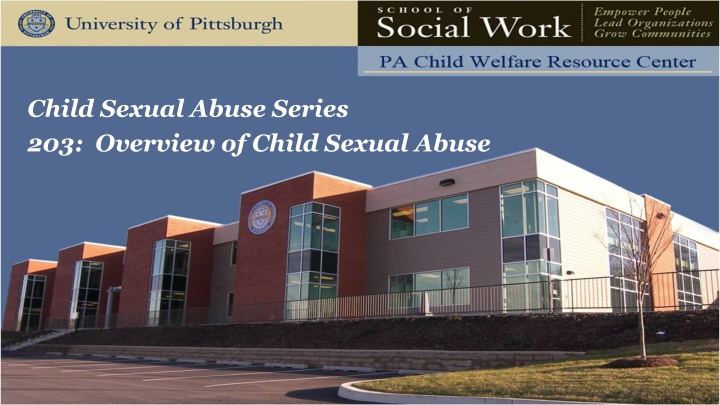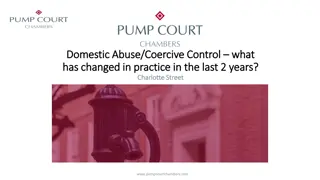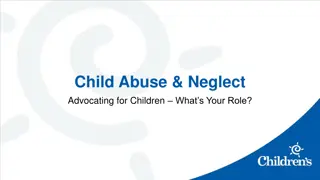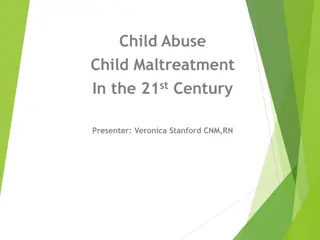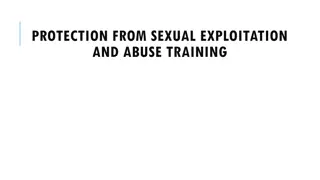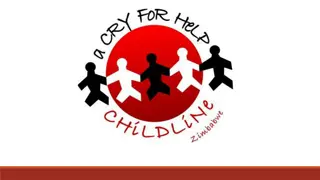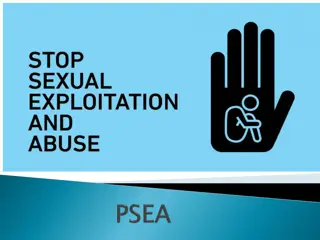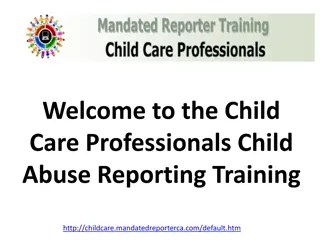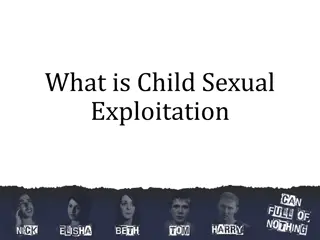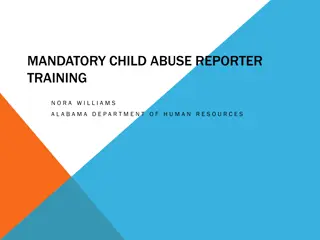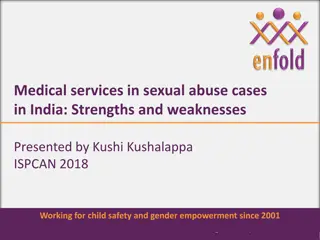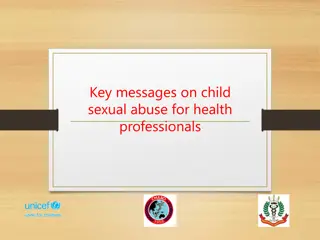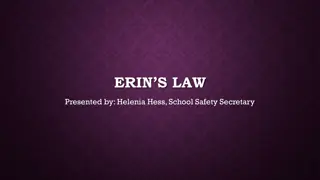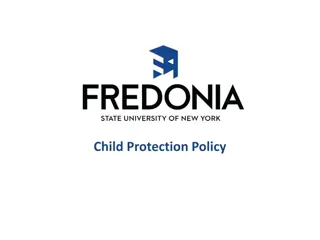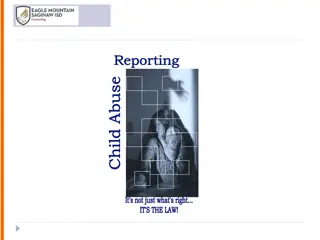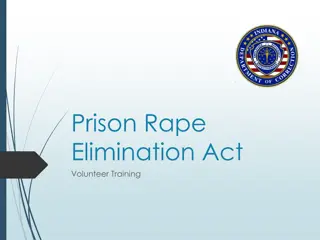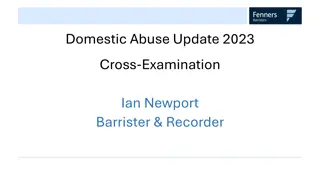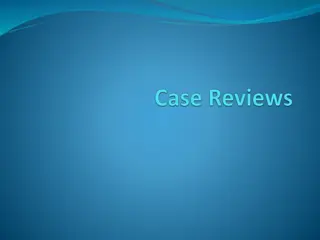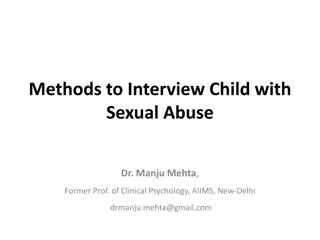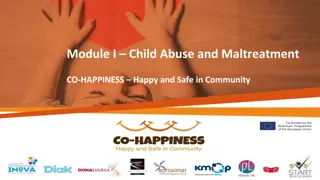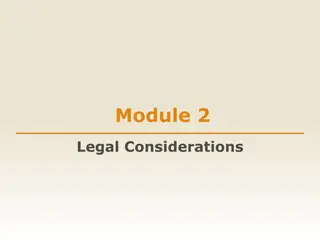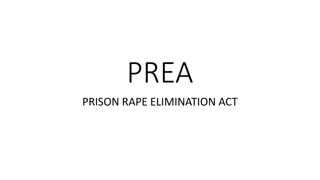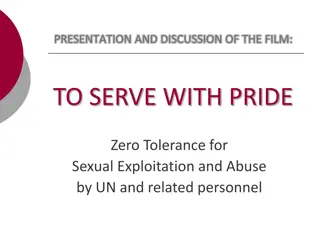Recognizing and Addressing Child Sexual Abuse
This series provides an in-depth overview of child sexual abuse, covering topics from recognizing signs in families to understanding age-appropriate sexual knowledge in children. It also delves into the competencies needed by professionals working in child welfare to handle cases of sexual abuse effectively.
Download Presentation

Please find below an Image/Link to download the presentation.
The content on the website is provided AS IS for your information and personal use only. It may not be sold, licensed, or shared on other websites without obtaining consent from the author.If you encounter any issues during the download, it is possible that the publisher has removed the file from their server.
You are allowed to download the files provided on this website for personal or commercial use, subject to the condition that they are used lawfully. All files are the property of their respective owners.
The content on the website is provided AS IS for your information and personal use only. It may not be sold, licensed, or shared on other websites without obtaining consent from the author.
E N D
Presentation Transcript
Child Sexual Abuse Series 203: Overview of Child Sexual Abuse
Housekeeping 15 min. Rule Breaks & Lunch Cell Phone, Computers, Side Bar Conversations Packets Parking Lot Idea Catcher The Pennsylvania Child Welfare Resource Center 203: Overview of Child Sexual Abuse 2
Introductions Name Agency Length of Employment w/Agency Employment Duties WIIFM The Pennsylvania Child Welfare Resource Center 203: Overview of Child Sexual Abuse 3
Competencies 203-3: The child welfare professional is able to recognize the patterns of interaction in families that maintain intra-familial sexual abuse. 203-4: The child welfare professional can recognize age-appropriate sexual knowledge and awareness in children and can identify abnormal and/or precocious sexual knowledge or preoccupation. The Pennsylvania Child Welfare Resource Center 203: Overview of Child Sexual Abuse 4
Competencies (continued) 203-6: The child welfare professional understands the individual and family dynamics of sexual abuse and can elicit and identify these dynamics during sexual abuse investigation interviews. 203-12: The child welfare professional is aware of his/her own emotional responses to child abuse and neglect and of the potential for these responses to interfere with the casework process. The Pennsylvania Child Welfare Resource Center 203: Overview of Child Sexual Abuse 5
Learning Objectives Articulate the laws, regulations, and policies that guide serving families facing child sexual abuse issues. Recognize individual and familial dynamics associated with sexual abuse (including research- based signs, characteristics, patterns, and cycles of sexual abuse). The Pennsylvania Child Welfare Resource Center 203: Overview of Child Sexual Abuse 6
Learning Objectives (continued) Recognize fundamental collaborative casework efforts related to serving children, youth, and families facing sexual abuse issues. Communicate personal values and beliefs regarding child sexual abuse and how those values and beliefs might affect serving families in which child sexual abuse issues exist. The Pennsylvania Child Welfare Resource Center 203: Overview of Child Sexual Abuse 7
Training Agenda I. Welcome and Introductions II. Values, Beliefs, Myths, & Facts III. Defining Child Sexual Abuse IV. General Dynamics V. Offender Dynamics VI. The Child and Family in General VII. The Investigation VIII. Planning and Collaborating IX. Effects of the Child Welfare Professional X. Closing and Evaluation The Pennsylvania Child Welfare Resource Center 203: Overview of Child Sexual Abuse 8
Legal Child Abuse Definitions Federal: CAPTA, as amended by the Keeping Children and Families Safe Act of 2003: (2) child abuse and neglect means, at a minimum, any recent act or failure to act on the part of a parent or caretaker, which results in death, serious physical or emotional harm, sexual abuse or exploitation, or an act or failure to act which presents an imminent risk of serious harm;1 Pennsylvania: (Child Protective Services Law) (b.1) The term child abuse shall mean intentionally, knowingly or recklessly doing any of the following: (1) Causing bodily injury to a child through any recent act or failure to act The Pennsylvania Child Welfare Resource Center 203: Overview of Child Sexual Abuse 9
Legal Child Abuse Definitions (continued) Child Protective Services Law (continued) (2) Fabricating, feigning or intentionally exaggerating or inducing a medical symptom or disease which results in a potentially harmful medical evaluation or treatment to the child through any recent act (3) Causing or substantially contributing to serious mental injury to a child through any act or failure to act or a series of such acts or failures to act (4) Causing sexual abuse or exploitation of a child through any act or failure to act. (5) Creating a reasonable likelihood of bodily injury to a child through any recent act or failure to act. (6) Creating a likelihood of sexual abuse or exploitation of a child through any recent act or failure to act. (7) Causing serious physical neglect of a child. The Pennsylvania Child Welfare Resource Center 203: Overview of Child Sexual Abuse 10
Legal Child Abuse Definitions (continued) Child Protective Services Law (continued) (8) Engaging in any of the following recent acts: (i) Kicking, biting, throwing, burning, stabbing or cutting a child in a manner that endangers the child (ii) Unreasonably restraining or confining a child, based on consideration of the method, location or the duration of the restraint or confinement (iii) Forcefully shaking a child under one year of age (iv) Forcefully slapping or otherwise striking a child under one year of age (v) Interfering with the breathing of a child (vi) Causing a child to be present at a location while a violation of 18 Pa.C.S. 7508.2 (relating to operation of methamphetamine laboratory) is occurring, provided that the violation is being investigated by law enforcement (vii) Leaving a child unsupervised with an individual, other than the child's parent, who the actor knows or reasonably should have known: The Pennsylvania Child Welfare Resource Center 203: Overview of Child Sexual Abuse 11
Legal Child Abuse Definitions (continued) Child Protective Services Law (continued) (A) Is required to register as a Tier II or Tier III sexual offender under 42 Pa.C.S. Ch. 97 Subch. H (relating to registration of sexual offenders), where the victim of the sexual offense was under 18 years of age when the crime was committed (B) Has been determined to be a sexually violent predator under 42 Pa.C.S. 9799.24 (relating to assessments) or any of its predecessors (C) Has been determined to be a sexually violent delinquent child as defined in 42 Pa.C.S. 9799.12 (relating to definitions) (9) Causing the death of the child through any act or failure to act (10) Engaging a child in a severe form of trafficking in persons or sex trafficking, as those terms are defined under section 103 of the Trafficking Victims Protection Act of 2000 (114 Stat. 1466, 22 U.S.C. 7102). (c) Restatement of culpability.--Conduct that causes injury or harm to a child or creates a risk of injury or harm to a child shall not be considered child abuse if there is no evidence that the person acted intentionally, knowingly or recklessly when causing the injury or harm to the child or creating a risk of injury or harm to the child (d) Child abuse exclusions.--The term "child abuse" does not include any conduct for which an exclusion is provided in section 6304 (relating to exclusions from child abuse) The Pennsylvania Child Welfare Resource Center 203: Overview of Child Sexual Abuse 12
CPSL Definition of Sexual Abuse or Exploitation 1. The employment, use, persuasion, inducement, enticement or coercion of a child to engage in or assist another individual to engage in sexually explicit conduct, which includes, but is not limited to, the following: i. Looking at the sexual or other intimate parts of a child or another individual for the purpose of arousing or gratifying sexual desire in any individual ii. Participating in sexually explicit conversation either in person, by telephone, by computer or by a computer-aided device for the purpose of sexual stimulation or gratification of any individual iii. Actual or simulated sexual activity or nudity for the purpose of sexual stimulation or gratification of any individual iv. Actual or simulated sexual activity for the purpose of producing visual depiction, including photography, videotaping, computer depicting or filming. This paragraph does not include consensual activities between a child who is 14 years of age or older and another person who is 14 years of age or older and whose age is within four years of the child s age. The Pennsylvania Child Welfare Resource Center 203: Overview of Child Sexual Abuse 13
CPSL Definition of Sexual Abuse or Exploitation (continued) 2. Any of the following offenses committed against a child, as defined in 18 Pa. C.S.: i. Rape ( 3121) ii. Statutory sexual assault ( 3122.1) iii. Involuntary deviate sexual intercourse ( 3123) iv. Sexual assault ( 3124) v. Institutional sexual assault ( 3124.1) vi. Aggravated indecent assault ( 3125) vii. Indecent assault ( 3126) viii. Indecent exposure ( 3127) ix. Incest ( 4302) x. Prostitution ( 5902) xi. Sexual abuse ( 6312) xii. Unlawful contact with a minor ( 6318) xiii. Sexual exploitation ( 6320) The Pennsylvania Child Welfare Resource Center 203: Overview of Child Sexual Abuse 14
Circumstances of Child Sexual Abuse Involve: From a clinical perspective, circumstances of Child Sexual Abuse involve: Sexual Exploitation of Children Dyadic Sexual Abuse Group Sex Child Pornography Sex Rings Child Prostitution The Pennsylvania Child Welfare Resource Center 203: Overview of Child Sexual Abuse 15
Sexual Abuse Theories Attachment Theory Behavioral Theory Biological Theory Cognitive-Behavioral Theory Integrated Theory Source: Terry, Karen J. Ph.D. & Tallon, Jennifer. Child sexual abuse: A review of the literature. The John Jay College of Criminal Justice: New York, New York. Retrieved from the World Wide Web on May 9, 2008 @ Children today know too much about sex. The Pennsylvania Child Welfare Resource Center 203: Overview of Child Sexual Abuse 16
The Pennsylvania Child Welfare Resource Center 203: Overview of Child Sexual Abuse 17
The Pennsylvania Child Welfare Resource Center 203: Overview of Child Sexual Abuse 18
Perpetrator Relationships to Children: Pennsylvania 2013 Relationship Father Mother Other family member Paramour Babysitter Household member Step-parent Other/unknown Daycare staff Residential facility staff Total Perpetrators 827 784 606 498 475 356 215 47 37 26 Source: Table 5 Relationships of Perpetrator to Child by Type of Injury (Substantiated Reports. 2013. DHS 2013 Annual Report. (16) The Pennsylvania Child Welfare Resource Center 203: Overview of Child Sexual Abuse 19
Adult Offenders Are usually adult males; however, females perpetrate as well Are almost always known to the child victim Rarely have one victim Primarily abuse children in the home; however, some also abuse children outside of the home Usually began perpetrating in adolescence or childhood May blame behaviors on marital difficulties, alcohol, and other drug addiction and/or stress. The Pennsylvania Child Welfare Resource Center 203: Overview of Child Sexual Abuse 20
Juvenile Offenders Include adolescents (13 to 17) who commit illegal sexual behavior as defined by sex crime statutes Represent a significant proportion of all individuals responsible for sex offenses Most juvenile offenders have not been child sexual abuse victims Most juvenile offenders will not become adult perpetrators The Pennsylvania Child Welfare Resource Center 203: Overview of Child Sexual Abuse 21
Juvenile Offenders (continued) Most differ from adult sex offenders in several ways Why they offend is still being researched; however, common characteristics do appear They are a diverse group of youth Although males still constitute the higher number of offenders against children; females do offend The Pennsylvania Child Welfare Resource Center 203: Overview of Child Sexual Abuse 22
Sexually Reactive Children Toni Cavanaugh Johnson used the term to refer children involved in sexual activity with other children that likely exceeds expectations for their age Occurs only as a reaction to: The child s own abuse Being chronically exposed to explicit sexual materials And/or being a child in a family where the boundaries regarding sexuality are too loose Source: Gil, E. & Johnson, T.C. (1993). Sexualized children: Assessment and treatment of sexualized children and children who molest. Rockville, MD: Launch. The Pennsylvania Child Welfare Resource Center 203: Overview of Child Sexual Abuse 23
Sexually Reactive Children (continued) The child is not to blame: They do not try to force or groom another child Nor do they make efforts to keep the sexual activity a secret Their behaviors are not ingrained patterns of sexually acting out but are not as easily redirected, as are the inappropriate behaviors of non-abused children Child s focus on sexuality is out of balance in relation to their peer group Source: Gil, E. & Johnson, T.C. (1993). Sexualized children: Assessment and treatment of sexualized children and children who molest. Rockville, MD: Launch. The Pennsylvania Child Welfare Resource Center 203: Overview of Child Sexual Abuse 24
The Pennsylvania Child Welfare Resource Center 203: Overview of Child Sexual Abuse 25
Non-Offending Parents Reveal a wide range of emotions; rarely will two parents react to disclosure in the same way Most believe, support, and take action Relationship with the perpetrator might assist in predicting willingness to support and protect the child History of physical or sexual abuse has little to no affect on whether the parent is less or more likely to believe, support, and protect Age of the child might affect willingness to support and protect The child s gender might affect willingness to support and protect A small percentage of parents know about the abuse and tolerate it Source: Elliot, Ann N. & Carnes, Connie N. (November 2001). Reactions of nonoffending parents to sexual abuse of their child. Child Maltreatment; 6; 314. Sage Publications. Retrieved from the World Wide Web on May 19, 2008 The Pennsylvania Child Welfare Resource Center 203: Overview of Child Sexual Abuse 26
Engaging Non-Offending Parents Accepting the client, but not any abusive or neglectful behaviors Remembering that the non-offending parents might be in shock Not placing blame Actively listening and reflecting on what non-offending parents say Allowing non-offending parents to vent feelings Universalizing (normalizing) feelings and beliefs Source: U.S. Department of Health and Human Services, Administration on Children, Youth and Families. (1994). Crisis intervention in child abuse and neglect: User manual series (1994). The Pennsylvania Child Welfare Resource Center 203: Overview of Child Sexual Abuse 27
Engaging Non-Offending Parents (continued) Using firm, but kind, confrontation Summarizing client feelings after extended listening Partializing (breaking into several smaller issues) concerns Educating or informing about forthcoming events, community resources Setting boundaries and limits on behaviors and contracting on acceptable alternatives Reframing client statements or behaviors to find the positive aspects Source: U.S. Department of Health and Human Services, Administration on Children, Youth and Families. (1994). Crisis intervention in child abuse and neglect: User manual series (1994). The Pennsylvania Child Welfare Resource Center 203: Overview of Child Sexual Abuse 28
Family Dynamics Consideration What rules might be enforced in the family and by whom? What kind of support is present for family members who are having problems? How is the family organized? Is there a hierarchy? If so, what does it look like? How does the family appear to outsiders? What kinds of boundaries exist in the family? How does the family communicate with one another? The Pennsylvania Child Welfare Resource Center 203: Overview of Child Sexual Abuse 29
Investigation Goals When investigating allegations of child sexual abuse, child welfare professionals must determine whether: The child s safety can be assured The child was sexually abused, per the Child Protective Services Law The abuse might occur again in the future, and/or what services might need provided to prevent the abuse from occurring once again. The Pennsylvania Child Welfare Resource Center 203: Overview of Child Sexual Abuse 30
Amended CPSL: Investigation of Reports a) Response to direct reports Upon receipt of a report of suspected child abuse by a perpetrator from an individual, the county agency shall ensure the safety of the child and any other child in the child s home and immediately contact the department. b) Response to reports referred to county agency by department Upon receipt of a report of suspected child abuse from the department, the county agency will immediately commence an investigation and see the child within the following time frames: 1) Immediately , if: i. emergency protective custody is required, has been or will be taken ii. it cannot be determined from the report whether emergency protective custody is needed 2) Within 24 hours of receipt of the report in all other cases. The Pennsylvania Child Welfare Resource Center 203: Overview of Child Sexual Abuse 31
Amended CPSL: Investigation of Reports (continued) c) Investigation An investigation will include the following 1) A determination of the safety of or risk of harm to the child or any other child if each child continues to remain in the existing home environment 2) A determination of the nature, extent and cause of any condition listed in the report 3) Any action necessary to provide for the safety of the child or any other child in the child s household 4) The taking of photographic identification of the child or any other child in the child s household , which will be maintained in the case file 5) Communication with the department The Pennsylvania Child Welfare Resource Center 203: Overview of Child Sexual Abuse 32
Amended CPSL: Notice of Investigation Prior to interviewing the subject of a report, the county agency is required to notify the subject who is about the interviewed of the following information: The existence of the report The subject s rights under 42 Pa. C.S. 6337 (relating to right to counsel) and 6338 (relating to other basic rights) The subject s rights pursuant to the CPSL in regard to amendment or expungement The subject s right to have an attorney present during the interview The Pennsylvania Child Welfare Resource Center 203: Overview of Child Sexual Abuse 33
Interviews As part of the sexual abuse investigation, at a minimum, child welfare professionals must interview: The child, if appropriate. The child s parents or other person responsible for the child s welfare. The alleged perpetrator of the suspected child abuse. The reporter of the suspected child abuse, if known. Eyewitnesses to the suspected child abuse. Neighbors and relatives who might have knowledge of the abuse. Daycare provider or school personnel, or both, if appropriate. Per 55 Pa. Code, 3490.55 (relating to investigation of reports of suspected child abuse) The Pennsylvania Child Welfare Resource Center 203: Overview of Child Sexual Abuse 34
Amended CPSL: Investigation of Reports: Interviews The amended CPSL now mandates that the investigation include interviews with all subjects of the report of suspected abuse, including the alleged perpetrator. Subject of the report, as defined by 6303 of the CPSL, is any child, parent guardian, or other person responsible for the welfare of a child or any alleged or actual perpetrator in a report made to DHS or a county agency. The Pennsylvania Child Welfare Resource Center 203: Overview of Child Sexual Abuse 35
Information Needed During the investigation stage, child welfare professionals must take steps to: Discover whether allegations are true Learn whether access issues exist Learn about the client s culture Find out whether elements of secrecy exist Discover whether medical indicators exist Determine who lives at the alleged child victim s home, in addition to the number of siblings, ages, etc. Establish the family s history of involvement with the agency Determine whether information offered by everyone corroborates Discover information that allows them to consider other possible scenarios that could explain reasons for referral The Pennsylvania Child Welfare Resource Center 203: Overview of Child Sexual Abuse 36
Collaboration with Law Enforcement Officials Collaboration with law enforcement officials will prove critical to the interview with the alleged perpetrator. The amended CPSL now states that: If the suspected child abuse is alleged to have been committed by a perpetrator and the behavior constituting the suspected child abuse may include a violation of a criminal offense, the appropriate county agency and law enforcement officials will jointly investigate the allegation through the established multidisciplinary investigation team. 6334.1 (2) If the suspected child abuse is alleged to have been committed by a person who is not a perpetrator and the behavior constituting the child abuse may include a violation of a criminal offense, law enforcement officials where the suspected child abuse is alleged to have occurred will be solely responsible for investigating the allegation. 6334.1 (2) The Pennsylvania Child Welfare Resource Center 203: Overview of Child Sexual Abuse 37
Reasonable Efforts If the court finds the child dependent and orders the placement of the child outside the home, the agency must make, document, and be able to state the reasonable efforts made to reunify the child with the family. Except as ordered by the court in cases where aggravated circumstances exist, the agency must make reasonable efforts to prevent removal, and once removed, to reunify the child with the family. If the agency alleges dependency and petitions the court for removal of the child, the court will ask the agency, as part of the petition and subsequent court orders, to prove that it made reasonable efforts to prevent removal. The Pennsylvania Child Welfare Resource Center 203: Overview of Child Sexual Abuse 38
Aggravated Circumstances Aggravated circumstances specifically citing sexual abuse include: The child or another child of the parent has been the victim of physical abuse resulting in serious bodily injury, sexual violence or aggravated physical neglect by the parent. The parent of the child has been convicted of any of the following offenses where the victim was a child: a felony under 18 Pa.C.S. 3121 (relating to rape), 3122.1 (relating to statutory sexual assault), 3123 (relating to involuntary deviate sexual intercourse), 3124.1 (relating to sexual assault). an equivalent crime in another jurisdiction. The attempt, solicitation or conspiracy to commit any of the offenses set forth in [main bullet 2 above] The parent of the child is required to register as a sexual offender under subchapter H of Chapter 97 (relating to registration of sexual offenders) or to register with a sexual offender registry in another jurisdiction or foreign country. Source: Commonwealth of Pennsylvania. The Juvenile Act (42 Pa.C.S. 6302, (relating to definitions)). The Pennsylvania Child Welfare Resource Center 203: Overview of Child Sexual Abuse 39
Service Plans After child safety has been assured, child sexual abuse-related service plans must: Address Protective Capacities that need to be enhanced to mitigate existing safety threats Address risk concerns Support (except as otherwise ordered by the court) goals and tasks that: prevent placement and/or reunify the child with the family Address concurrent planning efforts that consider any situation in which the child cannot be reunified with the family The Pennsylvania Child Welfare Resource Center 203: Overview of Child Sexual Abuse 40
Visitation According to 55 Pa Code 3130.68(a) (relating to visiting and communication policies): the county agency must provide opportunity for visits between the child and parents as frequently as possible but no less frequently than once every 2 weeks at a time and place convenient to the parties and in a location that will permit natural interaction, unless visiting is: Clearly not in keeping with the placement goal for example, in adoption or independent living. (1) Freely refused in writing by the parents. (2) Not in the child s best interest and is limited or prohibited by court order. (3) The Pennsylvania Child Welfare Resource Center 203: Overview of Child Sexual Abuse 41
Reunification If the child was removed from the home, reunification of the child back into the home in which a perpetrator who underwent treatment resides. Reintroducing a perpetrator into the family (if the child was not removed from the home and the perpetrator left the home to go into treatment as part of a Family Service Plan, successfully completed the treatment, and a qualified professional approved him/her to be with the child and family. The Pennsylvania Child Welfare Resource Center 203: Overview of Child Sexual Abuse 42
Secondary Traumatic Stress Secondary traumatic stress (STS) is natural consequent behaviors and emotions resulting from knowing about a traumatizing event experienced by a significant other the stress resulting from helping or wanting to help a traumatized or suffering person (Figley, 2002) A person can experience secondary traumatic stress through direct and indirect contact with a traumatized individual Ongoing exposure to traumatic stress creates symptoms related to other conditions, and is likely to be overlooked or assessed as some other problem Figley, C., Figley, K.R. Crisis Y2K (2002): The Green Cross Project. University of Pittsburgh. (2014). 313: Managing the Impact of Traumatic Stress on the Child Welfare Professional. Mechanicsburg, PA: University of Pittsburgh School of Social Work, Pennsylvania Child Welfare Resource Center. The Pennsylvania Child Welfare Resource Center 203: Overview of Child Sexual Abuse 43
Burnout Describes anyone whose health is suffering or whose outlook on life has turned negative because of the impact or overload of their work (Rothschild, B. 2006) Burnout and secondary trauma have similar roots. Both conditions involve the cumulative effects of stress. Both conditions elicit similar responses from affected employees While trauma deals with exposure to clients trauma and our own trauma, burnout adds the daily stressors of functioning in the overall workplace University of Pittsburgh. (2014). 313: Managing the Impact of Traumatic Stress on the Child Welfare Professional. Mechanicsburg, PA: University of Pittsburgh School of Social Work, Pennsylvania Child Welfare Resource Center. The Pennsylvania Child Welfare Resource Center 203: Overview of Child Sexual Abuse 44
Four characteristics of Sexual Abuse Cases that Contribute to Secondary Traumatic Stress and Burnout The acts themselves are terrible and terribly harmful. Sexual abuse violates fundamental social norms, and the lives of some victims dramatically attest to its devastating effects Cases are fraught with uncertainty. In many instances, it is not possible to determine whether the abuse occurred. Likewise, it is very difficult to determine the risk of future sexual abuse. Survivors are sometimes re-traumatized by repeated interviews, intrusive medical exams, court testimony, and separation from their families. Child welfare professionals are often unsuccessful. Survivors are not made to feel safe, and offenders may not be prosecuted or held accountable for their actions (U.S. DHHS, 1993) The Pennsylvania Child Welfare Resource Center 203: Overview of Child Sexual Abuse 45
